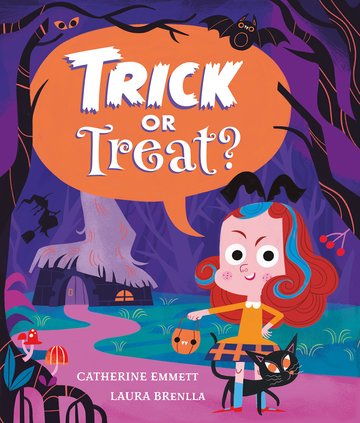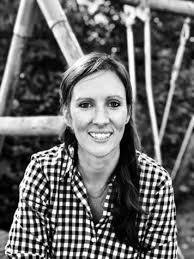An interview with picture book writer Catherine Emmett.

1. What do you enjoy about the picture book format? And what do you find difficult? It would be great to know about the rewards and challenges of writing in this format!
Over the years I have found that writing picture books just makes me very happy. It gives me a sense of purpose and direction which infuses other areas of my life too. When you have a strong idea and get a good sense of a story it’s a brilliant feeling. I think my favourite part is bringing all of that together.
In terms of what I find most difficult, I would say plot. I have a tendency to include too much in a story and sometimes I need to really pare it back to make sure the story isn’t too big for a picture book. It can be super satisfying when you get it right but very frustrating until you do!
2. I love the brightness of the illustrations – the neon oranges and the slime greens – which perfectly contrast with the spooky tone of the story. For those who might not know the process, could you talk us through a writer and illustrator work? Is it a separate or collaborative process?
Yes, I LOVE Laura Brenlla’s the illustrations for this book – they’re super characterful and I love the slightly retro vibe.
It’s always a strange process as typically writers and illustrators are kept apart and very rarely speak directly while a book is being made. I loved working on Trick or Treat as I got involved at a much earlier stage than I have before and got to see every part of the process. Usually, the publisher and author will chat about how they see the book generally and what style they think will work. Then typically the publishers will come up with an illustrator in a similar style and go from there. The first thing that the author generally sees are character sketches and sometimes there is a little back and forth there about how the team think the character should look. Next come the black and white roughs where you receive effectively pencil drawings of what the whole text will look like. Then finally, the colour roughs. There might be a few versions at each stage as details get added and tweaked.
Seeing the first illustrations are always my most favourite part of the process and I’ve been super lucky so far to have worked with illustrators who have brought so much to my texts.
 3. What drew you to write a Halloween story?
3. What drew you to write a Halloween story?
I was reading some Halloween picture books about everyone dressing up in Halloween costumes and wondered if I could reverse the idea. What if a Trick or Treater assumed they were visiting someone dressed up, but what if it was in fact a REAL witch? I loved the concept as it had so much potential for humour and a great twist - I couldn’t wait to write it.
4. I love the twist at the end of the story! (no spoilers, don't worry!) What tips do you have for writers who want to trick their readers?
Thank you! Twists are one of my favourite things in picture books – I love it when I think of a good one.
I think there is so much potential for a good page turn in a picture book – they work so well. There are lots of incredible transformation that are truly magical but which we take for granted. I used the transformation of a caterpillar into a butterfly in my first book King of the Swamp to give a surprise happy ending. Even transformations that we see as ‘everyday’ are incredible when they’re unexpected.
You can also use a reversal of expectations really well in picture books. In The Pet the badly behaved main character doesn’t get what he deserves, he goes to live in the zoo instead.
What’s important is that reversal of expectation – can you figure out what your reader thinks will happen next and turn it on its head?
5. How do you develop picture book ideas? Could you take us through the process of the initial seed of an idea to a fully-fledged, edited text?
Now usually I try and wait until I have a really strong commercial idea. I have an ideas list that I’m often looking through to figure out what the next text I write will be. I let the ideas percolate a bit and see which ones shout the loudest.
Once I have a strong idea and a good idea for how to execute it, I’ll try and get the first bit of rhyme down. Then is the most fun bit of figuring out the exact plot and letting the rhyme flow. Once I have a good first draft, I’ll get it to my agent and she’ll give me her thoughts. We might go back and forth a few times and then she’ll sub it. Hopefully it will be something that works for one of my existing publishers but if it’s a different style we might sub it more widely.
If it gets picked up then I’ll edit it with my editor. I’ve been lucky and usually don’t edit too much at this stage, as my agent is very editorial, so usually its in good shape before it is subbed. Then is the most fun stage of finding an illustrator and making it into a real live book!
6. Do you have any top tips on editing picture book texts? How do you ensure that every word counts?
You really need to be brutal. I find it works best to leave it alone for a few months so you can get some real distance from it. Anything less than that and I’m still reading it through gold tinted spectacles.
It’s important to make sure that every single line of the text is moving the story forward. I used to sometimes have two lines of a couplet that said similar things, but you really need every individual line to move things along - otherwise you have too many words of not enough story. Look at every single word and see if it is adding something new to the story itself, not just the meter pattern or rhyme scheme.
7. What advice do you have for picture book writers hoping to be published?
Enjoy your craft and practise as much as possible. Publishing picture books can be amazing and it can be heart breaking. The only thing you can control is your craft ,so focus on improving that as much as possible and enjoy your writing. Never lose the writing joy!
#Trick or Treat? by Catherine Emmett and illustrated by Laura Brenlla (published by Oxford Children's) is available to buy now
Read 'The Power of the Page Turn' by Catherine Emmett here
Catherine grew up in Newcastle and spent all of her childhood reading books. When she grew up, she spent fourteen years making spreadsheets and not reading any books at all. After advising a group of young girls to find a career that they loved, she decided to take her own advice. She packed up her husband and her three young boys, moved to rural Essex and started to write picture books. She now spends her days surrounded by words, animals and noisy boys. When she needs a bit of peace and quiet, she can be found running (very slowly) across muddy fields. www.catherineemmett.co.uk
Comments